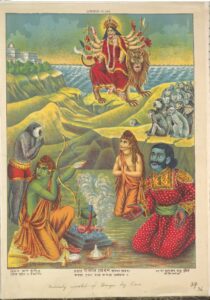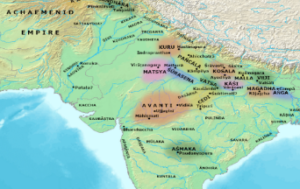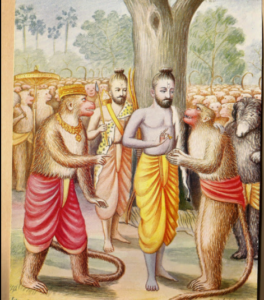आरुह्य कविताशाखां वन्दे वाल्मीकिकोकिलम||
Kujantam Ramrameti Madhuram Madhuraksharam.
Aaruhay Kavitashakhana Vande Valmikikokilam.
– Rama Raksha strotra

Valmiki Ramayana is a Sanskrit epic from ancient India. This paper seeks to explore the nuances of Vāstu śāstra from the perspective of the Valmiki Ramayana, which forms the core of Hindu Literature. The epic, traditionally ascribed to the Maharishi Valmiki, narrates the life of Rama, a prince of Ayodhya in the kingdom of Kosala. A glimpse into the Itihaas has shown mankind a balance between the four significant pillars of virtues -Dharma, Artha, Kama, and Moksa. The Epic of Ramayana- Rama Aayana– denotes Shri Rama’s journey from vice to virtue.
Shilpa śāstra is popularly known as vāstu śāstra, literally translates to the ‘science of architecture.’ It is a traditional Indian system of architecture based on ancient texts like Ramayana, Mahabharata, various other authorities like Agamas, Matsya Purana, Agni Purana, Brhat Samhita, Mayamatam, Manasara, and so forth. Vāstu-vidya or architecture finds its application in the construction of houses, fields, buildings, or structures of any kind, such as bridges (setu-bandhana), roads, gardens, and so forth. It is a subject that has a wide application of engineering, town planning, house architecture, palace architecture, and temple architecture. The origin of this science has been attributed to Viśvakarma, the divine architect of gods. Epic teaches us an elaborate method of the śilpaśāstra, which deals with the principles of the construction of palaces, passages, commonly used spaces like markets, royal palaces, courts, gardens, parks, and houses that are as high tall towers and multi-floor buildings-like skyscrapers. This science is fully treated in works like the Mānasara, Brāhmiya, and Manusara.
Valmiki Ramayana is a guiding light in the Shilpa Shastra as the Kosala Rajya was designed by well-known names such as Maya, Viśvakarma, Garga, and Manu. The layout design, measurements, ground preparation, space arrangement, and spatial geometry were entirely executed by them. The designs aim to integrate architecture in consonance with nature. Various parts of the structure, geometric patterns like yantra, symmetry in creation, and directional alignments, deal with the śilpaśāstras.
The overview of Ramayana by Maharshi in his trance- Valmiki Ramayana of 24000 stanzas was sung by Lava- Kusha Kumar of ‘Shri Rama -Devi Sita’ at a Conference of Muni Mandali. In order to analyze the principles of Vastu, the Four Kandas of the Ramayana are significant. They are: Bala Kanda (sarga 5), Ayodha Kanda (Sarga 56), Kiskindha Kanda (Vol 2, sarga 33) and Sundar Kanda (Sarga 2 and 3). These Kandas provide a detailed description of Shilpa Shastra, wherein the Architectural methods were well-advanced, as a fully planned city with ekyasipada vinasaya was implemented the Kosala Janpath, and the palaces and royal spaces were well-defined based on the forty-five devatas of the mandala.
Bala Kanda is the first volume of the Valmiki Ramayana, which is one of the two great epics of India. The Bala Kanda begins with the ascetic Valmiki questioning the famous sage Narada if there is any man who is truly virtuous. Narada replies that there is such a man and that his name is Rama. He then goes on to briefly describe Rama’s physical characteristics.

िोशलो नाम मुकितः स्फीतो जनपिो महान।्कनकवष्टः सरयूतीरेप्रभूतधनधान्यवान् 1 ॥५
Koshalo naam muktah saphito janapiyo mahaan kanakavashtah sarayooteereprabhootadhanadhaanyavaan1 .5.
A great kingdom named Kosala was a very popular and prosperous region in Bharat. One of the reasons for it was that the land on which this kingdom stood was well-fertile. Looking through the Itihaas, one finds that all the great civilizations were settled near the riverbank. Kosala Janpath was divided into the Sarayu river crossed across the land of Kosala Janpath and the capital city Ayodhya was built on the banks of the Sarayu river. A joyous and vast city in which all the varna were wealthy and prosperous. The well-renowned city is there in that kingdom, as it was personally built by Manu, the foremost ruler of mankind. The king’s palace (Rajamahal) was built on Ekasipada Vaastu. The royal palace was built in the Mitra Pada. That glorious city with well-devised highways and a magnificent city where everyone was prosperous and content. The royal passage was well-kept and showered with water and flowers regularly.
tām tu rājā daśaratho mahārāṣṭra vivardhanaḥ |
purīm āvāsayāmāsa divi devapatiḥ yathā || 1-5-9
The above extract clearly explains the reason why the Capital City of Ayodha was prosperous, as it was built on the bank of the Sarayu River. Acharya Maya addresses the ancient kingdom of Kosala for the first time in his text ‘Mayamatam’. Kosala raja extended across both banks of the Sarayu River. Ayodhya is the capital of this kingdom created by 25 Acharya and one of them was Acharya Manu. According to the Hindu epic, Kosala was ruled by kings who descended from the Sun. They were strong and powerful rulers who constituted an exemplary dynasty, they were beholders of dharma and respected all varnas. Sri Rama was a descendant of this dynasty. This dynasty was magnanimous because it was built on Ayatakara, which means that the city was built with twelve yojan in length and three yojan in breadth. The text unravels many such principles of Shilpa Shastra which were used to build the kingdom of Kosala. Measurement and akara (shape) played a vital role in creating a kingdom like Kosala and its capital city ‘Ayodhya’. In total, it was a massive area of around 5898 sq km. It was accurately structured with well-laid highways, adorned with great royal passages, and decorated with flowers strewn and scattered on both sides to give a majestic appearance.
Ayodhya Kandam (vol.1) Sarga 56 – This Kanda provides knowledge about creating the Kutia based on Vastu principles which were laid down by Sri Rama. In this sarga, Sri Rama calls Laxman to depart towards Chitrakoot which was inhabited by ascetics. Upon reaching the space, Shri Ram spoke to Vaidehi about flowering trees and the impressive nature surrounding bhallatokas and bilvas trees. Lord himself was eager to stay in Chitrakoot and instructed Laxman to create a Kutia in the charming woods with a spellbound serenity.
This is a very important sarga which is proceeding with the instruction of Shilpa Shastra clearly given by Sri Rama. The selection of materials clearly guides Sthapathi to understand the design of a space that was created with wood, it prescribes the level of ground and the need for creating a space without disturbance from the surroundings. This can be studied as a vast topic in Shilpa Shastra.
Kishkindha Kanda (Sarga 33)

“Sthapatya Veda is that aspect of the Cosmic Knowledge of Natural Law which maintains the buildings in which the individual lives and works, and the environment in which he moves, well set in cosmic harmony.”
—Maharishi Mahesh Yogi
The magnificence and luxury of Kishkindha and its inmates are depicted here. Lakshmana on the invitation of Angada proceeds through the streets of the city examining its glory. The glory that Lakshmana witnessed at the splendid kingdom of Kishkindha, which included colossal caves, crafted with jewels, replete with flowered orchards, and richly rife with gemlike objects. The city was perfect for the jati of vanar.
स तम् रत्नमयीम् दिव्याम् श्रीमान् पुष्पित काननाम् |
रम्याम् रत्न समाकीर्णाम् ददर्श महतीम् गुहाम् || ४-३३-४
Kishkindha was splendid, sumptuous, and gigantic with mansions and multi-storied that embellished with various precious stones, and it was enlivened with blossoming trees that bore the fruit of every relish. In that city, Lakshmana witnessed not single-storied but multi-storied buildings, with Mt. Vindhya and Mt. Meru, and he even saw mountain rapids with pure water.
Sunder Kanda (Adhyaya-2, 3, 4)
Lanka is an island 1000 miles away from the southern shore of India. Hanuman flew around 100 yojan to Lanka during the day, as stated by Valmiki ji in Ramayana. The entire city and the suburbs were naturally air-conditioned here. Hanuman saw the city of Lanka with its beautiful banner of gold strung in various garlands resembling the city of god, Amaravati. The city consisted of proper roads with clean, broad, and well-laid boulevards. Hundreds of watch towers were installed to ensure the safety of the citizens. The row of houses appeared like a constellation of stars in the sky.
pālitāṃ rākṣasendreṇa nirmitāṃ viśvakarmaṇā |
plavamānāmivākāśe dadarśa hanumān purīm || 5-2-20
Hanuman saw that the city of Lanka ruled by Ravana the king of Rakshasas, which was constructed by Visvakarma (architect of Gods), and looked as though it were floating in the sky. The city was built with jewels and gems all around and the palace was like the moon present in its constellation. It looks like the residence of Shiva, the Kailasha peak itself, with its huge skyscrapers that almost seem to be flying and touching the sky. The heart of the city was located at the peak of the mountain. It appeared that Lanka was up in heaven rather than on earth and the city appeared as though it was hanging like a garland.
To conclude, Ramayana is an epic that is a guiding force in the principles of Sthapathy. The scripture draws a very strong foundation in the field of Shilpa Shastra.
OmTatSat.



